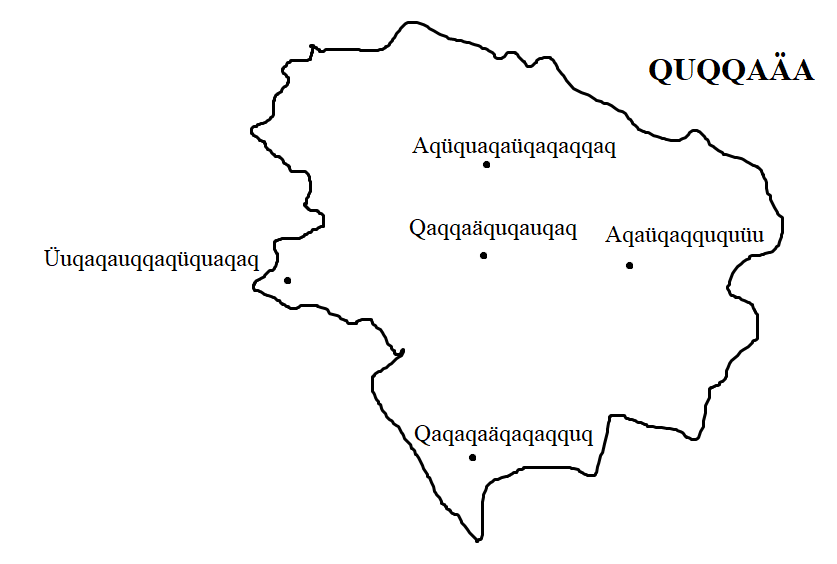Quququqquq: Difference between revisions
m (→Inflection) |
m (→History) |
||
| Line 13: | Line 13: | ||
== History == | == History == | ||
Old Quququqquq had two consonants /t k/. After an epidemic hit, speakers could only communicate in a whistled form of the language, which didn't distinguish between the two consonants. When they later developed a written language based on this, the distinction was thus lost. Words that became homophonous were distinguished by compounding and derivation. | Old Quququqquq had two consonants /t k/. After an epidemic hit, speakers could only communicate in a whistled form of the language, which didn't distinguish between the two consonants. When they later developed a written language based on this, the distinction was thus lost. Words that became homophonous were distinguished by compounding and derivation. | ||
== Phonology == | |||
== Morphology == | == Morphology == | ||
Revision as of 00:52, 12 November 2024
Pages with the prefix 'Quququqquq' in the and 'Talk' namespaces:
In Angai, Quququqquq (/ku:ku:'kʊkkʊk/, natively quququqquq qaqqaäa /kùkùkùkːùk kàkːàáà/ [kʰùvūvūkūɰˀ kʰàkǣǽǣ]) is the most phonologically minimalistic Kawenic language, with just one consonant /k/, two vowels /u a/, and two tones (high, Romanized ä ü and low, Romanized a u). It's spoken in the island nation of Quqqaäa (pronounced /'kʊkə/ in English).
Quququqquq grammar is mainly inspired by Finnic languages. Like Estonian, Quququqquq is a partially fusionalized agglutinative language with a large noun case system.
Todo
Needs more ü ä
Quqqaäa
The official name of the country is Quqqaäau Uqaqaüquaqquq (Republic of Quqqaäa).

History
Old Quququqquq had two consonants /t k/. After an epidemic hit, speakers could only communicate in a whistled form of the language, which didn't distinguish between the two consonants. When they later developed a written language based on this, the distinction was thus lost. Words that became homophonous were distinguished by compounding and derivation.
Phonology
Morphology
Nouns and adjectives
Quququqquq nouns and adjectives have 17 cases:
- nominative: the syntactic subject of any verb, intransitive or transitive
- genitive: the possessor of a noun, or the semantic patient of a verb (the noun that undergoes change as a result of a transitive verb)
- partitive: an object of a transitive verb that is not semantically a patient
- illative: 'into'
- inessive: 'in, inside'
- elative: 'out of'
- allative: 'towards; recipient of an act of giving'
- adessive: 'at, by, next to'
- X-ADE qaü Y-NOM is used for 'X has Y': Qauaqqüqua qaü qüqququqau 'Qauaqquq has a cuckoo'
- ablative: 'from; a person from whom something is taken, stolen, etc. from'
Inflection
Nouns and adjectives have four principal parts:
- I: nominative singular (never ends in -qq)
- II: genitive singular (never ends in -q)
- III: genitive plural (often but not always ends in -qa; never ends in -q)
- IV: partitive plural (always ends in -q; sometimes III+q but not always)
Given principal parts nouns are declined as follows:
| singular | plural | |
|---|---|---|
| nominative | I | II-q |
| genitive | II | III |
| partitive | I-q | IV |
| illative | II-ü | III-ü |
| inessive | II-qqu | III-qqu |
| elative | II-qqüq | III-qqüq |
| allative | II-qua | III-qua |
| adessive | II-qqa | III-qqa |
| ablative | II-qqäq | III-qqäq |
| translative | II-ququ | III-ququ |
| terminative | II-quaä | III-quaä |
| durative | II-quqqü | III-quqqü |
| essive | II-qaua | III-qaua |
| exessive | II-qauaq | III-qauaq |
| comitative | II-qqäqu | III-qqäqu |
| abessive | II-uqqau | III-uqqau |
| instructive | II-qqaqqu | III-qqaqqu |
Examples:
|
|
|
Verbs
TODO: Do verbs have principal parts?
Quququqquq verbs have several differences from Standard Average European:
- negative verb that marks TAM
- emphatic forms instead of subject pronouns (cf. Old Irish)
- impersonal forms
Infinitives end in -uqa or -üqa depending on the verb. The connegative form (the form used after the negative verb) is always identical to the imperative.
| indicative mood | imperative mood | ||||||||||
|---|---|---|---|---|---|---|---|---|---|---|---|
| nonpast | past | nonpast emphatic | past emphatic | ||||||||
| per. | no. | affirmative | negative | affirmative | negative | affirmative | negative | affirmative | negative | affirmative | negative |
| 1st | sg. | quqüäqau | äau quqüä | quqüäqää | äqqau quqüä | quqüäqauqqa | äqauqqa quqüä | quqüäqääuqqa | äqqauqqa quqüä | - | - |
| 2nd | quqüäqu | äu quqüä | quqüäqäqu | äqqu quqüä | quqüäqqä | äqäqqä quqüä | quqüäqäqqä | äqqäqqä quqüä | quqüä | äua quqüä | |
| 3rd | quqüäquq | ää quqüä | quqüäqä | äqq quqüä | quqüäquqqa | äqaquqqa quqüä | quqüäqäqqa | äqqaqqa quqüä | quqüäqa | äuqaa quqüä | |
| 1st | pl. | quqüäqaüq | äqaüq quqüä | quqüäqäaüq | äqqauq quqüä | quqüäqaüquqq | äqaüquqq quqüä | quqüäqäaüquqq | äqqaüquqq quqüä | quqüäqaqaüq | äuqaqaüq quqüä |
| 2nd | quqüäququq | äququq quqüä | quqüäqäuquq | äqququq quqüä | quqüäquququqq | äquququqq quqüä | quqüäqäuququqq | äqquququqq quqüä | quqüäqaquq | äuqaquq quqüä | |
| 3rd | quqüäqüüq | äqüüq quqüä | quqüäqäüüq | äqqüüq quqüä | quqüäqüüquqq | äqauqq quqüä | quqüäqäüüquqq | äqqauqq quqüä | quqüäqääq | äuqääq quqüä | |
| impersonal | quqüäqua | äqua quqüä | quqüäqäua | äqqua quqüä | - | - | - | - | quqüäqaua | äuqaua quqüä | |
qaüqa 'to be'
Pronouns
Personal pronouns have no nominative forms; emphatic forms of verbs are used instead to emphasize a pronominal subject.
Pronouns have emphatic forms too.